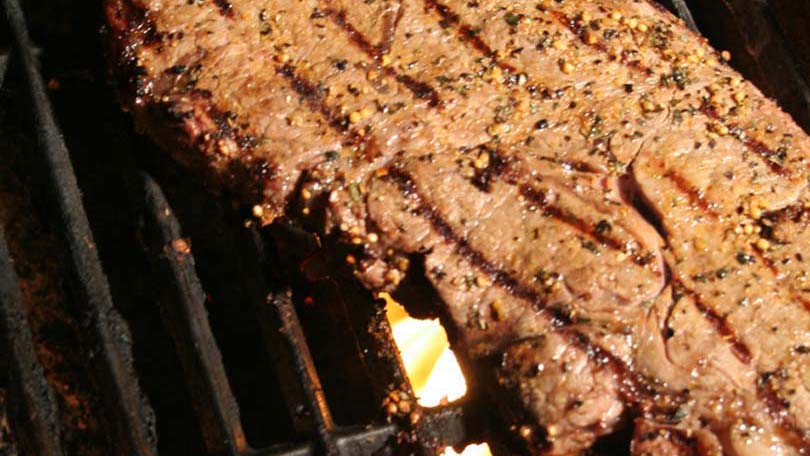
Grilling a thick, juicy steak on a backyard barbeque is a fun way to entertain but, just like any other meal, a grilled steak dinner is best when prepared by someone who knows what he or she is doing. When the weather is warm and it’s time to fire up the grill, by following a few simple instructions, you can dazzle your friends and family by cooking like a pro. Grilling is not only perfect for cooking a steak, it’s also a fun way to prepare delicious and healthy fruits and vegetables to complete the meal.
Preparation
The first thing on the to-do-list is to preheat the grill. If you are using a charcoal grill, wait until your single layer of coals turn ashy white. If you are using a gas grill, crank it up to ‘very hot.’ Some barbeque experts feel that a steak will grill faster and more evenly if the meat is allowed to reach room temperature before grilling. Another suggestion is to trim the steak of any fat so that the steak won’t curl. By using a pair of tongs, the trimmed fat can be used to oil the grate, which will avoid sticking. Seasoning is a matter of personal taste.
An important tip to remember when grilling any type of meat is to either use a different platter or to wash your platter after placing the meat on the grill and before taking it off. This procedure will help to avoid any food contamination.
Meat Thermometers
There are many different types of thermometers available and your choice of thermometer should be determined by several factors including the type of grill you are using, as well as your preference of cut and experience. Using a meat thermometer will enable you to determine the level of doneness, which can also help to ensure that any bacteria present have been destroyed. Many health authorities recommend cooking red meat to at least medium to kill bacteria that may be present.
Remember that your steak will certainly remain juicier and more flavorful if you are not repeatedly puncturing the meat with a fork or probe. Although most backyard cooks use a common fork to turn the meat, barbeque pros use tongs or a spatula to turn their streaks. Keep in mind that it is best to avoid cutting or puncturing a steak if you can avoid it. This will prevent all the natural juices from escaping. Let steaks rest for 2-3 minutes before serving, which will allow the juices to flow outward from the center, leaving the whole steak nice and juicy.
Grilling Times by Thickness of Steak
| Thickness | Rare | Medium | Well | Heat |
| 1″ | 8-10 | 12-14 | 16-20 | High |
| 1 1/2″ | 10-14 | 16-20 | 22-26 | High |
| 2″ | 12-16 | 18-22 | 24-28 | Medium |
These are total cooking times. Divide in half for each side. Times are approximate and will vary depending on the type of grill, fuel, weather conditions, etc.
If a meat thermometer is not available, some cooks use the pressure test to check their steaks. When the steak is close to being done, press it with your index finger or the flat side of a grilling fork to get a feel for it. A rare steak will be soft, a medium steak will be firm but yielding, and a well-done steak will be firm.
Choosing the cut of steak
One of the most important things to know about choosing the right cut of meat is that it is muscle, and the relative condition of the muscle determines the taste and tenderness of the meat. Therefore, a protected and little-used muscle such as the tenderloin will be tender and finely grained with a relatively mild flavor, while a stronger, well-exercised muscle will be tougher but more flavorful. Therefore, even though tenderloin is the most expensive and the tenderest of cuts, the tenderloin may not be the cut with the most flavor.
There are several other cuts that can be very tender and are apt to be more flavorful than the tenderloin, such as the Porterhouse, Flank, Rib, and Sirloin. These cuts generally offer better flavor and usually contain better marbleizing of fat content, which lends both flavor and moisture to the steak.
When purchasing steaks, avoid buying meat that contains large fatty areas. Consider requesting a premium cut of beef as opposed to select cuts, and if possible attempt to purchase premium cuts that have been aged a minimum of twenty days and a maximum of twenty-eight days. Cuts that have been dry aged will provide the best flavor and will usually be very tender.
The T-bone steak, top loin, and Delmonico steak come from the animal’s rib and loin sections. These steaks are free of connective tissue and tender enough to withstand a grill’s high, direct heat without drying out. Although the rib and loin sections are the best bets for grilling, you might want to try a cheaper cut in the chuck (shoulder) called the flatiron steak, which also grills up nicely.
It may take a while to get the hang of mastering the grill, but with a little patience and practice, you should be able to barbeque steaks to mouth-watering perfection.




























